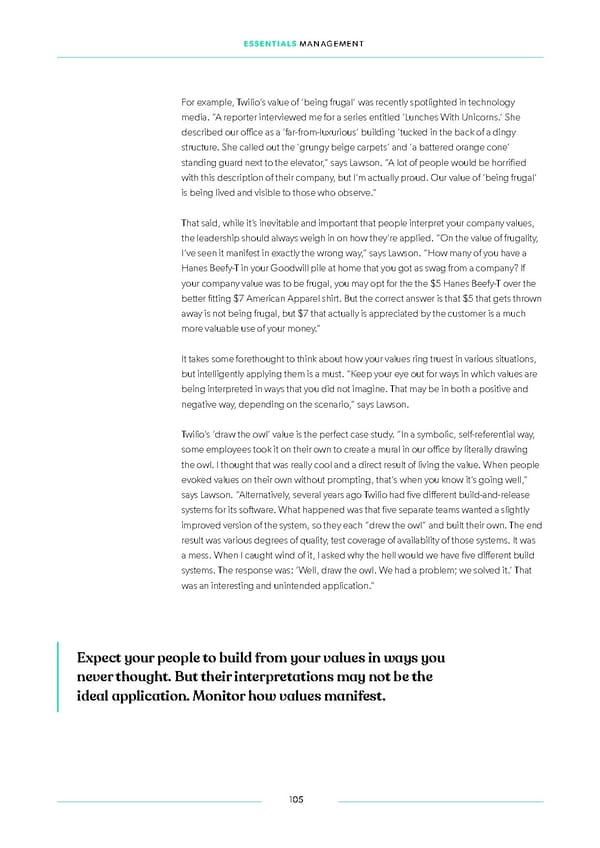ESSENTIALS MANAGEMENT For example, Twilio’s value of ‘being frugal’ was recently spotlighted in technology media. “A reporter interviewed me for a series entitled ‘Lunches With Unicorns.’ She described our oiffce as a ‘far-from-luxurious’ building ‘tucked in the back of a dingy structure. She called out the ‘grungy beige carpets’ and ‘a battered orange cone’ standing guard next to the elevator,” says Lawson. “A lot of people would be horriifed with this description of their company, but I’m actually proud. Our value of ‘being frugal’ is being lived and visible to those who observe.” That said, while it’s inevitable and important that people interpret your company values, the leadership should always weigh in on how they’re applied. “On the value of frugality, I’ve seen it manifest in exactly the wrong way,” says Lawson. “How many of you have a Hanes Beefy-T in your Goodwill pile at home that you got as swag from a company? If your company value was to be frugal, you may opt for the the $5 Hanes Beefy-T over the better iftting $7 American Apparel shirt. But the correct answer is that $5 that gets thrown away is not being frugal, but $7 that actually is appreciated by the customer is a much more valuable use of your money.” It takes some forethought to think about how your values ring truest in various situations, but intelligently applying them is a must. “Keep your eye out for ways in which values are being interpreted in ways that you did not imagine. That may be in both a positive and negative way, depending on the scenario,” says Lawson. Twilio’s ‘draw the owl’ value is the perfect case study. “In a symbolic, self-referential way, some employees took it on their own to create a mural in our oiffce by literally drawing the owl. I thought that was really cool and a direct result of living the value. When people evoked values on their own without prompting, that’s when you know it’s going well,” says Lawson. “Alternatively, several years ago Twilio had ifve different build-and-release systems for its sotfware. What happened was that ifve separate teams wanted a slightly improved version of the system, so they each “drew the owl” and built their own. The end result was various degrees of quality, test coverage of availability of those systems. It was a mess. When I caught wind of it, I asked why the hell would we have ifve different build systems. The response was: ‘Well, draw the owl. We had a problem; we solved it.’ That was an interesting and unintended application.” Expect your people to build from your values in ways you never thought. But their interpretations may not be the ideal application. Monitor how values manifest. 105
 Essentials Management First Round Capital Page 104 Page 106
Essentials Management First Round Capital Page 104 Page 106